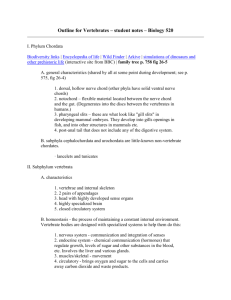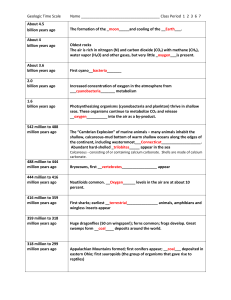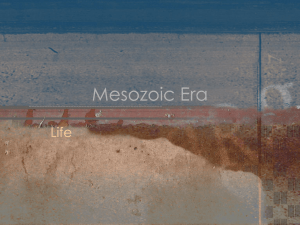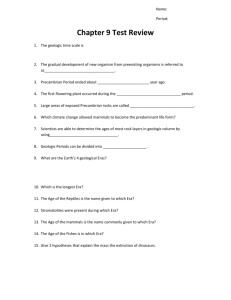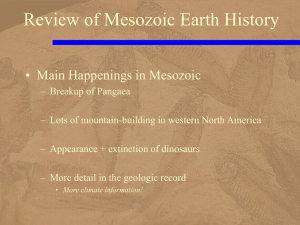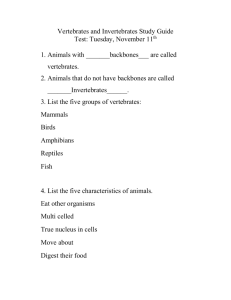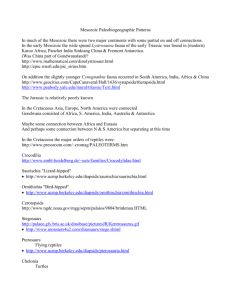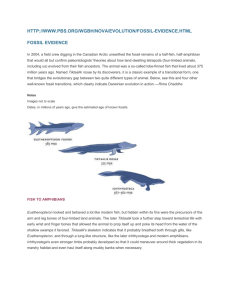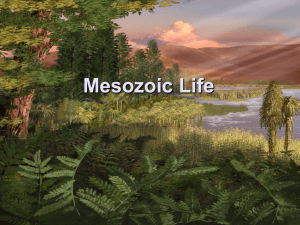Mesozoic & Cenozoic - Integrative Biology
advertisement
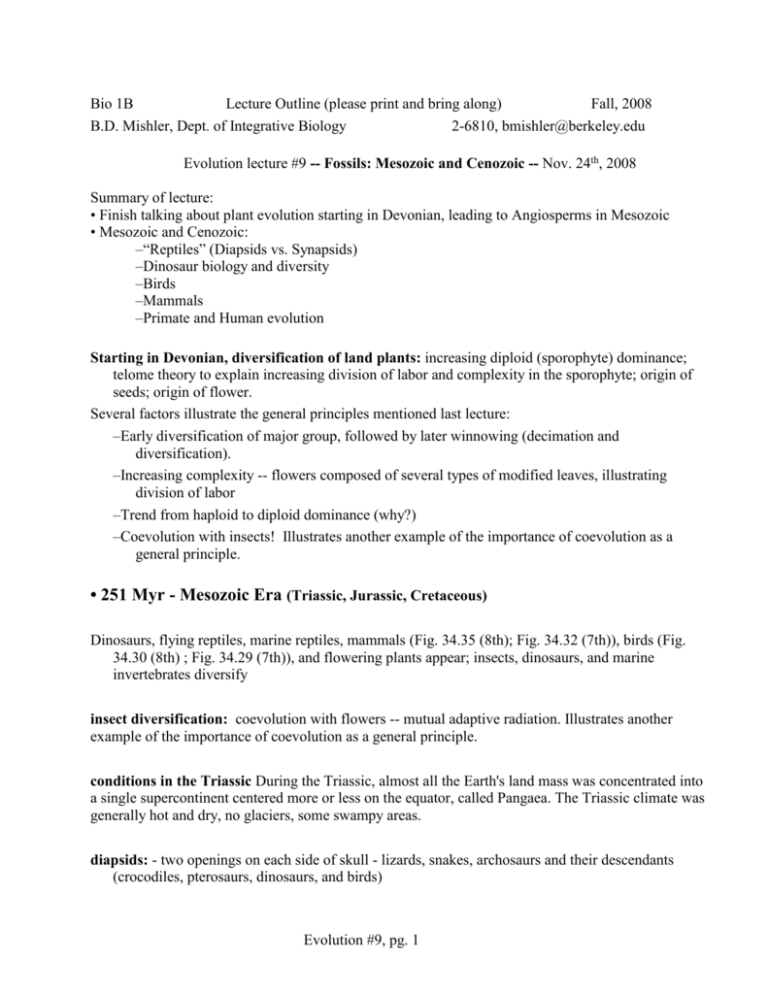
Bio 1B Lecture Outline (please print and bring along) Fall, 2008 B.D. Mishler, Dept. of Integrative Biology 2-6810, bmishler@berkeley.edu Evolution lecture #9 -- Fossils: Mesozoic and Cenozoic -- Nov. 24th, 2008 Summary of lecture: • Finish talking about plant evolution starting in Devonian, leading to Angiosperms in Mesozoic • Mesozoic and Cenozoic: –“Reptiles” (Diapsids vs. Synapsids) –Dinosaur biology and diversity –Birds –Mammals –Primate and Human evolution Starting in Devonian, diversification of land plants: increasing diploid (sporophyte) dominance; telome theory to explain increasing division of labor and complexity in the sporophyte; origin of seeds; origin of flower. Several factors illustrate the general principles mentioned last lecture: –Early diversification of major group, followed by later winnowing (decimation and diversification). –Increasing complexity -- flowers composed of several types of modified leaves, illustrating division of labor –Trend from haploid to diploid dominance (why?) –Coevolution with insects! Illustrates another example of the importance of coevolution as a general principle. • 251 Myr - Mesozoic Era (Triassic, Jurassic, Cretaceous) Dinosaurs, flying reptiles, marine reptiles, mammals (Fig. 34.35 (8th); Fig. 34.32 (7th)), birds (Fig. 34.30 (8th) ; Fig. 34.29 (7th)), and flowering plants appear; insects, dinosaurs, and marine invertebrates diversify insect diversification: coevolution with flowers -- mutual adaptive radiation. Illustrates another example of the importance of coevolution as a general principle. conditions in the Triassic During the Triassic, almost all the Earth's land mass was concentrated into a single supercontinent centered more or less on the equator, called Pangaea. The Triassic climate was generally hot and dry, no glaciers, some swampy areas. diapsids: - two openings on each side of skull - lizards, snakes, archosaurs and their descendants (crocodiles, pterosaurs, dinosaurs, and birds) Evolution #9, pg. 1 synapsids: - single opening low on each side of skull - mammal-like reptiles and mammals plesiosaurs: marine reptiles of the Mesozoic. icthyosaurs: marine reptiles of the Mesozoic pterosaurs: flying reptiles of the Mesozoic Turtles, lizards, snakes, crocodilians "dinosaurs": distinguished from other diapsid reptiles by erect gait (straight legs attached underneath their bodies). Dinosaur diversity: many types of medium- to large-sized predators and herbivores; limited in other ways such as lack of digging and climbing forms. Mass extinction at end of Cretaceous (dinosaurs, pterosaurs, icthyosaurs and plesiosaurs extinct): Pangaea breaking up, climate changing, sea level changing, meteorite impact (Fig. 25.15 (8th); Fig. 26.9 (7th)) Luis Alvarez (UC Berkeley!): discovered that the usually rare element iridium is abundant in a thin layer of rocks that mark the end of the Cretaceous, and proposed that a large meteorite or asteroid (at least 10 km wide!) struck earth at that time and caused the Cretaceous extinction Almost all large vertebrates and many other species went extinct. At the end of the Cretaceous 65 mya, called the K/T boundary, almost all large vertebrates (dinosaurs, pterosaurs, plesiosaurs), many tropical vertebrates, most plankton and many tropical invertebrates, especially reef-dwellers, became extinct, and many land plants were severely affected. Surviving groups radiated to become the dominant flora and fauna today. Surviving groups, including insects, mammals, birds, and flowering plants on land, and fishes, corals, and mollusks in the ocean went on to diversify tremendously soon after the end of the Cretaceous. It was a major event in the history of life that profoundly affected life on earth since. No one doubts that the world would be very different had this mass extinction not occurred. The probably impact crater has been located in Mexico. Later, the impact crater in Yucatan was found near the port city of Progresso and is known as the Chicxulub structure. The crater is 200-300 km in diameter and lies beneath 1100 m. of limestone. It was known to the Mexican national petroleum company (now Pemex). After the Berkeley group suggested an impact at the K/T Evolution #9, pg. 2 boundary, Pemex scientists recognized that their observations were consistent with the idea that they had found the impact crater. Roughly 200,000 km3 of material was ejected and vaporized as a result of the impact. archaeopteryx: classified as the first bird (150 Myr). Distinguishing characteristics were feathers (asymmetric), wings, and an ability to glide, “dinosaurs” with proto-feathers and feathers have recently been discovered. modern bird diversity • 65 Myr - Cenozoic Era (Tertiary (Paleocene, Eocene, Oligocene, Miocene, Pliocene), Quaternary (1.8 Myr) (Pleistocene, Holocene (Recent) (10,000 yrs)) Diverse forms of mammals, birds, flowering plants, and insects Major radiation of mammals, birds and pollinating insects. By end of Eocene mammals of every size and lifestyle had appeared with many similar to modern forms and others very different. Radiation of angiosperms, including appearance of grasses. Humans (Homo sapiens) appear in the Pleistocene Mass extinction at end of Pleistocene, primarily non-marine, many large mammals extinct • Transitional Fossils Many examples of transitional fossils are known, e.g., Paleozoic: “fish” to amphibians (tetrapods) (Fig. 34.20 (8th); Fig. 34.19 (7th)), amphibians to “reptiles” Mesozoic: mammal-like reptiles to mammals, ‘dinosaurs’ to birds, wasps to ants Cenozoic: land mammals to whales (Fig. 22.16 (8th); Fig. 22.18 (7th)). • Primate evolution Evolution #9, pg. 3 The two major groups of the primates are the prosimians and the anthropoids (Fig. 34.37 (8th); Fig. 34.38 (7th)). prosimians: (“premonkeys”) lemurs of Madagascar, lorises, pottos, and tarsiers that live in tropical Africa and southern Asia. anthropoids: monkeys, apes and humans (see new display in VLSB outside library) anthropoid evolution: binocular vision, larger brain, opposable thumb, complex social interactions hominoids: apes and hominids hominids: humans and their direct ancestors hominid genera: Ardipithicus, Australopithecus, and Homo. hominid evolution: bipedalism, enlargement of brain, and cultural evolution. At various times a number of different hominid species apparently coexisted. Homo habilis: used tools consistently Homo erectus: used fire Homo neanderthalensis: Neanderthals Homo sapiens: Cro-Magnons, modern humans. Early hominids, unlike chimps and gorillas, lived in relatively dry areas. The oldest hominid fossils date to 6 mya and are very similar to chimpanzees. That date is consistent with estimated time of their most recent common ancestor based on DNA sequence comparisons, suggesting that earlier specimens, if they are found, are common ancestors. Evolution #9, pg. 4
